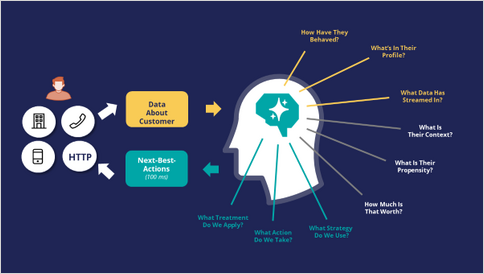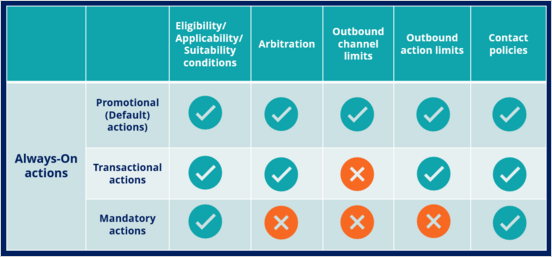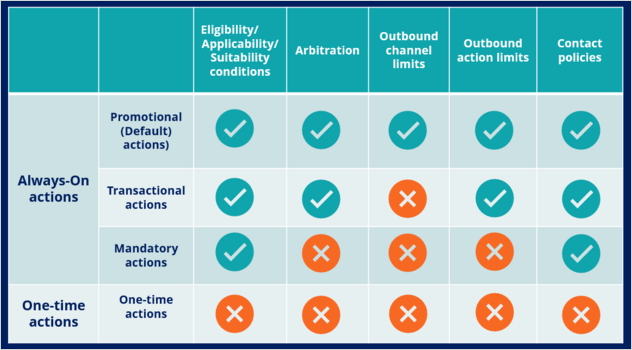
Working of the always-on brain in outbound
What do customers expect from business?
Customers are more empowered than ever before. As a result, they have very high expectations of the experiences they receive from their service providers. These experiences must be meaningful, consistent, and personalized across every channel they interact with.
In alignment with customer expectations, Pega Customer Decision Hub™ is designed to deliver the right message, to the right customer, at the right time, on the right channel.
This approach not only provides a better experience for customers, it also helps the business improve its customer relationships over the long term.
The always-on brain
Pega Customer Decision Hub is the "always-on brain" that acts as a single, centralized decision authority.
The always-on brain carries out 1:1 customer engagement across channels.
"Always-on" means that the brain constantly monitors each customer's context across channels. When it detects a need, it selects and delivers the appropriate offer, retention message, or service recommendation in the customer's preferred channel.
The brain uses data about the customer, including past behaviour, profile information, and contextual data that may, for example, stream from their device, as input. It leverages advanced AI techniques to predict customer context, propensities, and relevance. It also uses stored decision strategies to trigger messages and actions at the moment the customer will be most receptive to them. As a centralized resource, the brain enables you to deliver consistent and personalized Next-Best-Actions across all channels.
Customer engagement channels
Customer interactions take place on various channels, which can be broadly classified as "owned" and "paid".
Owned channels are the channels owned by the business, such as a self-service web portal, contact center, or mobile application. In these channels the business has more control over customer engagement activities.
Paid channels are owned by a third party, for example social media platforms such as Google and Facebook. Businesses have to pay to use these channels for customer engagement activities.
Owned channels can be further classified as inbound and outbound channels.
An inbound channel is used when a customer approaches the business, via, for example, a self-service web portal.
An outbound channel is used by the business to send a message to the customer, via, for example, email or SMS.
The flow of information and the mechanics of delivering Next-Best-Actions is different in inbound and outbound channels.
Inbound interactions
When a customer interaction takes place on an inbound channel, the channel identifies the customer, then the brain evaluates the Next-Best-Action for that customer and sends the result back to the same channel, in real-time. The customer's response to the action is recorded by the system, and the cycle repeats.
Outbound interactions
Always-on outbound means that the brain sends outbound messages, via email or SMS, to customers only when it's appropriate.
There are two types of outbound interactions: always-on actions and one-time actions.
Always-on actions
Always-on actions are typically the actions that are available for the Next-Best Action framework (Always-on brain) to select and deliver the appropriate communication to the customer.
This can happen in three ways:
a. Promotional actions (Default): The brain is configured to proactively send out messages on a scheduled basis when relevant. It evaluates the Next-Best-Action for each customer identified in a segment, which contains the potential list of customers to whom you want to send messages. In most cases, customer responses arrive after the message has been sent. When customers respond, the responses are recorded in the system and used to evaluate the next-best action. The always-on brain considers all the engagement policy conditions, applies arbitration, outbound action/channel limits, and contact policies while determining the appropriate action and it delivers the top-ranked action. Promotional actions are the default method of communication.
b. Transactional actions: When a customer event is detected that is significant to the business, for example, a customer abruptly ends an online transaction, Customer Decision Hub receives the data from the event stream. The brain then evaluates the next-best action and sends the resulting action, such as a notification email with a link to continue the incomplete transaction, to the customer. In this case, the system triggers the outbound message only for the customer for whom the event occurred. Transactional actions are regulated by engagement policies, arbitration factors, action limits, and contact policies. However, the outbound channel limits are disregarded, as long as it is one of the qualified actions.
c. Mandatory actions: In certain situations, it might be necessary to inform certain customers about changes such as an increase in interest rates or network outages. These types of communications are referred to as mandatory actions, that must be sent out promptly. These actions are regulated by engagement policies and contact policies. Arbitration, outbound channel limits, and outbound action limits do not apply to these actions. However, contact policies are still applied to these actions to ensure the same actions are not delivered repeatedly.
Here's an illustration of which policies and constraints apply to different outbound interactions.
One-time actions
One-time actions are typical batch communication that all or a subset of customers receive at a specific date and time. These actions are executed in a Business Operations Environment. No engagement policies or constraints are applied to these actions, and everyone receives the same action.
a. One-time communication: In exceptional circumstances such as a planned maintenance activity in certain areas, you want to contact all or a subset of your customers outside of the regularly scheduled updates. In such cases, you can initiate a one-time communication, which does not coordinate with the outbound schedule. This type of communication typically applies to urgent or time-sensitive matters and does not repeat automatically.
This Topic is available in the following Modules:
If you are having problems with your training, please review the Pega Academy Support FAQs.
Want to help us improve this content?






